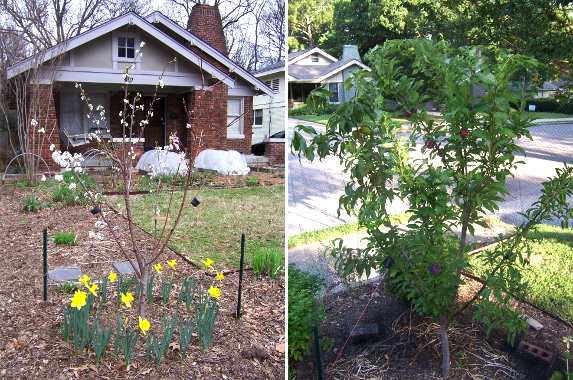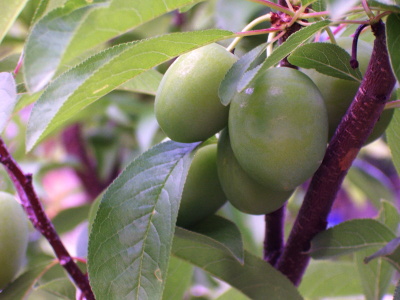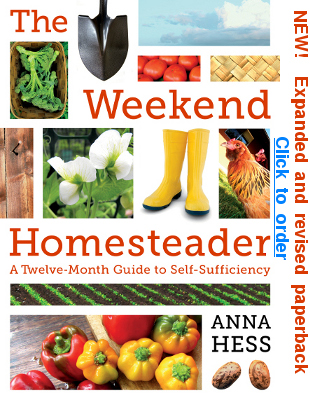
Fruit cocktail tree

Have you ever wondered
about those "fruit cocktail trees" you see for sale in glossy
magazines? Brian Cooper tried out a dwarf tree with five
different varieties grafted on --- Elberta Peach, Belle of Georgia
Peach, Santa Rosa Plum, Redgold Nectarine, and Moorpark Apricot.

His tree was pretty big
when he brought it home and it fruited the first year. (The
photos above show the tree a year later when it had been pruned and
trained.)
Brian wrote "All of the
grafts produce fruit, but it is a challenge to keep them balanced so
they grow evenly."
His advice is timely
since I'm going to be grafting
some new varieties onto my pear trees this winter. I hadn't understood
why my orcharding books recommend adding no more than four different
varieties to one tree, but Brian's experience rang a bell.  Of
course it would be tough to keep multiple varieties on an even keel so
that the most vigorous doesn't take over the tree.
Of
course it would be tough to keep multiple varieties on an even keel so
that the most vigorous doesn't take over the tree.
Has anyone else had
experience with fruit cocktail trees? I'd be curious to hear if
your results are any different if you stick to the same species for all
varieties (for example, four types of apples on one tree.)
Want more in-depth information? Browse through our books.
Or explore more posts by date or by subject.
About us: Anna Hess and Mark Hamilton spent over a decade living self-sufficiently in the mountains of Virginia before moving north to start over from scratch in the foothills of Ohio. They've experimented with permaculture, no-till gardening, trailersteading, home-based microbusinesses and much more, writing about their adventures in both blogs and books.
Want to be notified when new comments are posted on this page? Click on the RSS button after you add a comment to subscribe to the comment feed, or simply check the box beside "email replies to me" while writing your comment.

I attended the scion exchange for California Rare Fruit Growers and met a man who has an apple tree with 92 different grafts. I have about 5 different varies on my apple tree and I like the fact that each is a different flavor, texture and time of harvest and I would definitely do this again when I get moved to my new place. Two of my grafts are rare red interior colored apples with great flavor and texture. Grafting is also a way to preserve rare almost extinct varies and expand their propagation.
There is also a man in the club who has grated citrus trees with many different grafts but he indicated that the rootstock can affect the flavor of citrus.
I have an apple double graft (Fuji and Granny smith). Still only small, so I can't give any helpful experience. I have read someone say the would not grow a multigraft again. But they seem such a great idea, for limited space, and easily increasing varieties. I can't see it would be such a problem keeping dominant varieties in check.
I have read a few people recommending against them, on the forums below.
But the only reason I have heard, is it is difficult to manage the strong versus weak graft, and the tree is weaker and less productive in general.
http://forums.gardenweb.com/forums/load/calif/msg0216275023644.html
http://www.daleysfruit.com.au/forum/trees-in-one-hole/
http://www.daleysfruit.com.au/forum/fruit-salad-trees/
I just found your blog and am really enjoying it. As to your fruit tree dilemma keeping the tree balanced, try Espalier. That way it doesn't matter if the varieties grow at different rates. We have a four way pear on a 4' fence with varieties about 18" apart on the dwarf rootstock. I grafted another 2 way pear this spring that we will Espalier as well. Fruit Salad are typically 'Bud Grafted', so you can put the grafts where ever you want them. My wife and I volunteer in a local community orchard here in Portland that has Espalier apples and pears that are over 60 years old, are over 20' wide and produce like crazy. They are easy to prune and harvest fruit too. No laddes required. Just a thought. Thanks again for your blog. It's a great read that has stimulated lots of projects in our spare time. Please stay safe. Have a Great Day! jc